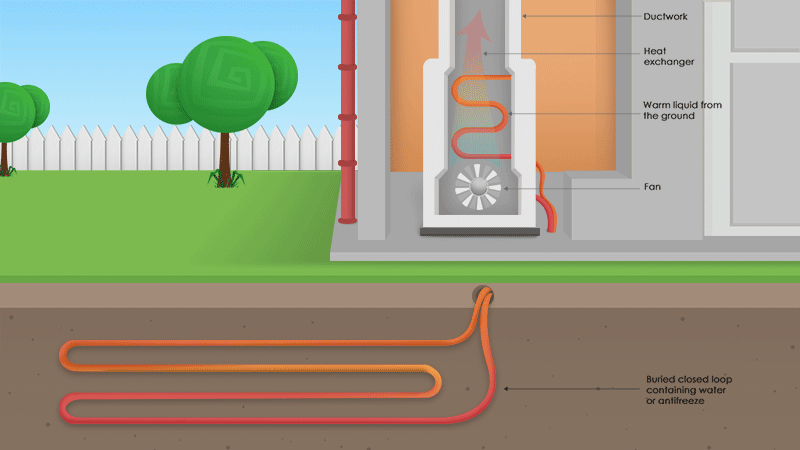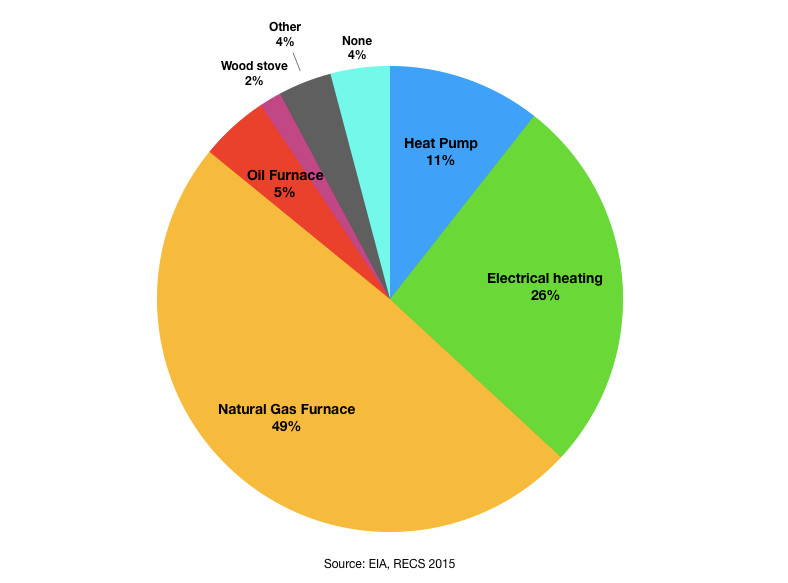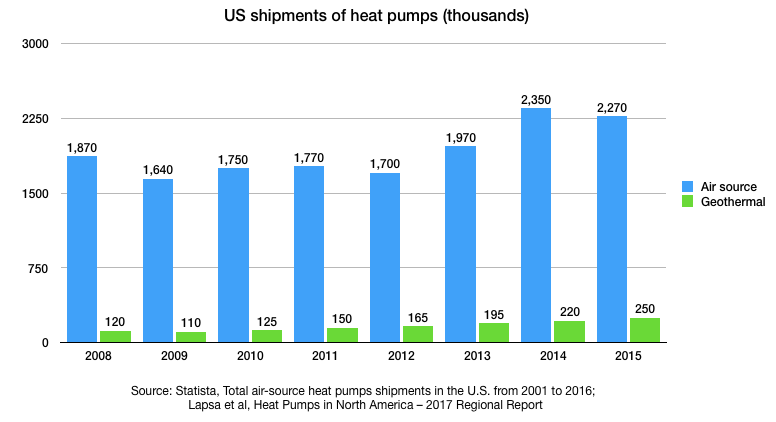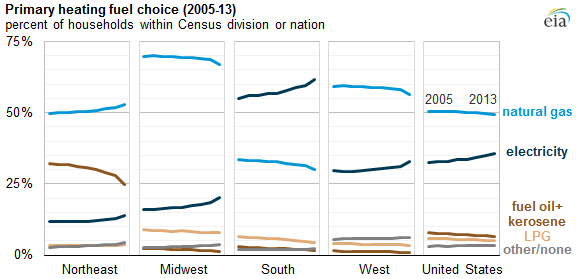Latest news about Bitcoin and all cryptocurrencies. Your daily crypto news habit.
The magic of heat pumps — Moving American homes to sustainable heating
This is a summary of two months of research that we did into renewable energy and net-zero buildings with the intention of starting a company in the space. The post outlines the opportunity and challenges of using geothermal heat pumps to heat and cool homes in the US. We interviewed researchers, contractors and home owners to understand the technology and how people think about replacing heating systems in their homes. We ultimately decided to not pursue the opportunity ourselves, but we are posting this so hopefully others can learn from our findings. If you have questions or believe we have missed something important, please comment on the story or get in touch.
— Henrik Berggren & David Kjelkerud
Introduction
When examining the solutions available to move our society to a sustainable future, the heat pump is looking remarkably promising. That’s because it has the potential to radically improve the efficiency of one of the most energy-consuming activities we do: heating and cooling our buildings.
The building sector worldwide consumes more than 30% of total energy and over a third of that is used for heating and cooling our homes, offices and other buildings. The energy use in the sector is expected to increase massively over the coming decades as the fast-growing middle class in countries with hotter climates adopt air-conditioning.
The heat pump is a heating and cooling technology that can reduce energy use compared to other heating systems by up to 70%. Heat pumps have seen traction in Europe and Japan, but are not yet commonplace around the world. According to the International Energy Agency, if 30% of the building sector would adopt heat pumps it could reduce worldwide carbon emissions by 6%. Heat pumps have the potential to have the single largest impact on reducing carbon emissions and anthropogenic climate change.
We believe that the US residential heating market is going to shift from using primarily fossil fuel powered systems to electric and that the shift will be driven by the rise of rooftop solar, increased environmental awareness and the increasing effectiveness and utility of heat pumps. We believe geothermal heat pumps integrated with an intelligent software layer could be a worthy contender to oil and propane furnaces when it comes to price and efficiency, and for home owners with rooftop solar who generate a surplus of electricity it’s almost always the cheaper choice.
Technology Animation from FurnaceCompare.com
Animation from FurnaceCompare.com
The clever thing with heat pumps is that rather than generating thermal energy, they move it from one place to another. This allows them to be incredibly energy efficient compared to traditional furnaces. A heat pump needs a heat source, which can be air or in the case of geothermal heat pumps, the ground. Thermal energy is extracted from the ground via a coolant-filled ground loop and then transferred inside the home. A common application of same principle is the refrigerator, which moves heat from inside the fridge to the back (you feel it if you hold your hand back there). By reversing its process heat pumps can also be used for cooling, so in summers they can substitute for an AC.
Geothermal heat pumps are the most efficient type of heat pump and can be up to 5 times as efficient as a gas furnace or electric baseboard heaters. They are a larger investment than air source heat pumps and requires more space to accommodate the heat exchange loop buried underground.
Opportunity
US heating market breakdown
There are three main fuel types dominating the US residential heating and cooling market today: Natural gas (49%), oil (5%) and electricity (36%).
On the hardware side fossil fuel furnaces are most popular (54%) followed by electrical heaters (26%) while heat pump market share is currently at 11%. Geothermal heat pump penetration has been growing steadily at an average of 14.7% annually since 2009.
 Source: http://bit.ly/2Fx5iNF
Source: http://bit.ly/2Fx5iNF Sources: http://bit.ly/2r1YrIG, http://bit.ly/2r2u2d4
Sources: http://bit.ly/2r1YrIG, http://bit.ly/2r2u2d4
Geothermal heat pumps are still small compared to air source heat pumps but their share has grown from 6.5% to 11% of total units shipped.
Trends in the market
Low price of natural gas
In 2017 the price of natural gas was close to an all time low due to increased supply from new and more efficient harvesting methods, mainly fracking. Gas prices are projected to double in the next 10–12 years (See EIA’s Annual Energy Report, p51), dependent on predictions on availability of new gas and oil resources and improvements to drilling technology. Renewables are increasingly becoming competitive with fossil fuels but consensus is that natural gas will be around and competitively priced for a long time still.
Rise of residential solar
Residential solar had a slower year in 2017, but looking back at the last few years growth has been explosive and is projected to grow 10x over the next 20 years according to the EIA. Solar roofs have the potential to hasten the shift to electric heating as home owners who generate electricity surplus will likely prefer electric heating systems over fossil fuel based ones.
Increased environmental awareness among homeowners
Homeowners are becoming increasingly aware of the environmental impact as they improve and make upgrades to their home. Anecdotally, home owners told us that having green technology installed would be something they would proudly tell their friends. In the US, construction firms are seeing an increased demand for “Green projects” due to clients requesting it and not just to meet environmental regulation (Source).
Electrification of the home
Over the coming decades we think technology in the home will move to using electricity as the sole source of energy, including space & water heating, appliances and vehicles. Already today electricity is increasing its share as heating fuel, even though natural gas prices are at an all time low (Source). This is partly due to more efficient electrical heating options, like heat pumps, gaining market share. Residential solar is also growing while oil and liquified petroleum gas (LPG) are declining due to being inefficient, risky and complex to operate.
 Source: https://www.eia.gov/todayinenergy/detail.php?id=18131Home owners stay longer and renovate more
Source: https://www.eia.gov/todayinenergy/detail.php?id=18131Home owners stay longer and renovate more
The housing market is changing as well. Home owners tend to stay longer in their homes suggesting the appetite for renovation and improvements going up according to research done by Zillow. The spending on home improvement in the US is increasing after years of stagnation post financial crisis. In addition, more and more people view their house as a financial investment. Home improvement is estimated to be a $340B market with heating being about $50B of it. 80% of that $50B is add-ons and replacements, not entirely new systems.
Barriers to adoption
Low price of natural gas
The low price of natural gas is currently the biggest challenge for the success of geothermal heat pumps. If a home is equipped with a natural gas furnace for heating (and the need for cooling is limited) there is no financial reason switching to a heat pump, in fact, you’d be worse off. And even if gas prices increase it would be hard to compete until it at least doubles, according to forecasts, will take 10+ years. The only configuration where a heat pump could compete with natural gas on the US market today is if a home has installed solar panels that generate enough surplus electricity to power a heat pump. In this scenario a geothermal heat pump would pay for itself in less than 10 years in most cases.
Long payback periods
The complexity of the installation and the somewhat more expensive hardware leads to long payback periods for many homes and reduces the financial attractiveness of the investment. However, financing options can help home owners to invest in the long term without having to pay money up front. Similar programs have been pioneered by solar installation companies like Sunrun and SolarCity.
Limited market education
There seems to be a lack of knowledge and skepticism in the US market due to how complex this technology is, both to maintain and install. Geothermal heat pumps are more complicated to install than other heating systems as you need to drill/trench to install the ground loop. We also have anecdotal evidence that the drilling machinery used on some sites is oversized and made for well drilling even though the hole diameter needed for the ground loops is significantly smaller. This leads not only to geothermal being more costly but also a bigger undertaking.
Innovation is slow
Heat pumps have been around since the 1940’s and has seen slow but steady improvement. According to Jan-Erik Nowacki, energy researcher at the Royal Institute of Technology in Sweden that has been studying heat pumps for almost 40 years, the coefficient of performance (COP) is increasing with 1.5% per year on average which has resulted in a doubling of COP in the last 40 years. There are also a number of other improvements, for example the addition of an electric cartridge that allows heat pumps to be a reliable heat source in colder climates.
Paperwork
Since geothermal heat pumps are relatively new to government officials and drilling is needed, getting the right permits can be complicated. The permits required are unique for each state and sometimes counties have specific rules. Because Geothermal heat pumps are uncommon local governments may not have processes to handle requests easily/quickly.
Product
The product would be a both an improved heating system and installation service for single family homes. The company would also provide financing options to limit the need for an upfront cash investment.
Heating system
The system would come in two parts 1) A geothermal heat pump 2) A software layer connected to it providing value added services like a thermostat, smart grid optimization and cloud integration enabling remote performance analysis.
Installation service
The company would provide end to end installation in homes using their own professionals or vetted sub-contractors. They would replace an existing system with a heat pump, install the ground loop and connect it to the existing infrastructure of the house.
Improvements
We believe there are a number of improvements to be made both in the core heat pump technology but also around the installation process and services for the customer. Below is a table outlining some of them and their potential impact.
1. Software tool for remote design, deployment, management of installers etc.
Software can make several steps in the installation process more efficient. In addition the company will be specialized on one type of system which will increase performance. The benchmark would be Thermondo, a German heating company who claim 4.5x improvement in installation efficiency compared to other contractors.
2. Drilling
By using smaller rigs that are optimized for drilling for geothermal the company could reduce the time and cost of drilling. Installing the ground loop is around 50% of the total cost of a geothermal heat pump, so improvements to the drilling process can have large impact.
3. Smart grid connectivity
Software layer that will optimize for heating the house during off-peak hours that could reduce operating costs up to 12%.
4. Thermostat
According to research done by Nest smart thermostats can bring down operating costs with 12% which could come default with a system.
5. Data and analytics layer
The system would submit data to the cloud enabling monitoring of performance and faster detection of potential issues.
Final thoughts
Based on the developments in the market for fossil fuels, increased environmental awareness and regulation as well as the numerous improvements that can be made, both on installation and in the system itself we believe that it’s possible to build a business selling these heating systems to the US market.
There are still unanswered questions on the optimal strategy for such a company. For example, where do you start geographically? How do you make customer acquisition effective? Do you use an in-house installation team or outsource it? We would also expect to do a deeper dive into the technology. Some are of the opinion that air-source heat pumps would be a better option to start with, as they are simpler to install and still provide high efficiency compared to traditional heating systems.
Regardless of these questions, we believe there’s a good company to be built here. The interest in geothermal and heat pumps is just growing, and we don’t see it stopping. Just recently, the Breakthrough Energy fund (by Bill Gates et al.) released their investment areas and geothermal and heat pumps were both included. With increasing environmental awareness and the growth of rooftop solar, more people will be looking for an electricity based heating solution, and heat pumps are really the only contender.
If you are excited about the opportunity and want to talk more, get in touch!
The magic of heat pumps was originally published in Hacker Noon on Medium, where people are continuing the conversation by highlighting and responding to this story.
Disclaimer
The views and opinions expressed in this article are solely those of the authors and do not reflect the views of Bitcoin Insider. Every investment and trading move involves risk - this is especially true for cryptocurrencies given their volatility. We strongly advise our readers to conduct their own research when making a decision.